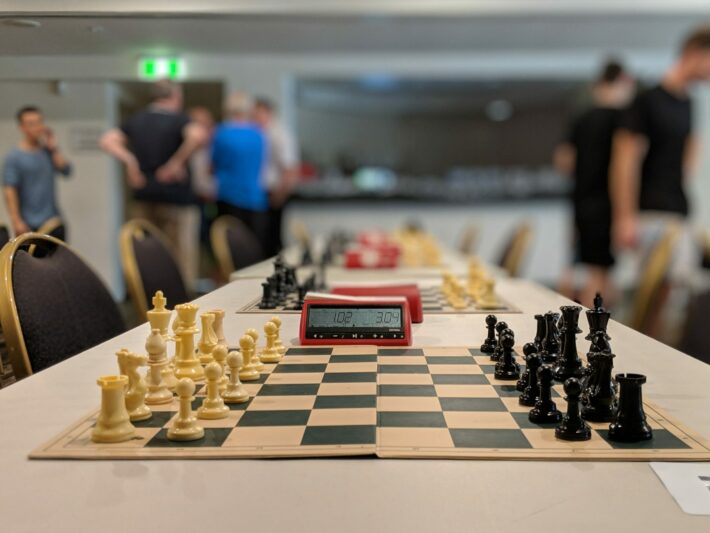Imagine sitting across from your opponent, feeling a mix of excitement and anticipation as you prepare to make your opening move. As a chess player, you know that the right opening strategy can set the tone for the entire game. Today, we’re going to explore a powerful weapon in the chess world: the Benko Gambit- a strategic opening that has gained popularity among chess enthusiasts and professionals alike for its ability to catch opponents off guard and create dynamic positions.
Throughout this piece, we’ll dive into the depths of the Benko Gambit, uncovering its strengths, and weaknesses, and providing you with valuable insights to outsmart your opponent.
What is the Benko Gambit and why is it a formidable weapon?
The Benko Gambit, also known as the Volga Gambit, is an aggressive chess opening that arises after the moves 1.d4 Nf6 2.c4 c5 3.d5 b5. It involves Black sacrificing a pawn in exchange for long-term strategic compensation.
By offering this pawn, Black aims to seize control of the initiative, activate their pieces, and create imbalances on the board. The Benko Gambit is a formidable weapon because it challenges White to navigate unfamiliar territory, disrupts their plans, and often leads to complex and dynamic positions.
How to prepare your opening repertoire to face the Benko Gambit?

Preparing your opening repertoire to face the Benko Gambit requires a solid understanding of the key ideas and common moves in this opening. Studying annotated games by strong players who have experience with the Benko Gambit can be a valuable resource.
Additionally, analyzing specific variations and practicing against chess engines can help you familiarize yourself with the critical positions that arise. It’s crucial to develop a clear plan and be prepared for the aggressive nature of the opening.
Which are the critical moves to avoid falling into Benko Gambit traps?
Falling into Benko Gambit traps can quickly lead to a disadvantageous position. One critical move to avoid is accepting the gambit too early. Instead, opt for the solid move 4.Nf3, decline the pawn and prepare to defend your position.
Another move to be cautious of is 5.bxa6, which can open up the a-file and give Black counterplay. Instead, it’s often recommended to develop your pieces harmoniously and focus on solidifying your position before grabbing material.
What are the key principles for defending against the Benko Gambit?
Defending against the Benko Gambit requires a combination of solid positional play and tactical awareness. Key principles include maintaining a strong pawn structure, developing your pieces to active squares, and finding counterplay opportunities.
It’s essential to avoid becoming too passive and allowing Black to dictate the game. By keeping your pieces coordinated and creating threats of your own, you can put pressure on Black’s position and exploit their weaknesses.
Should you accept or decline the Benko Gambit?
Accepting or declining the Benko Gambit is a crucial decision that can significantly impact the course of the game. Accepting the gambit can lead to sharp and dynamic positions, giving you a chance to seize the initiative. On the other hand, declining the gambit allows you to maintain the material advantage and play more solidly and strategically.
Ultimately, the decision depends on your playing style and comfort level with tactical complications. Understanding the pros and cons of each option will help you make an informed choice during your games.
How to counterattack and seize the initiative against the Benko Gambit?

Counterattacking and seizing the initiative against the Benko Gambit is a key strategy to disrupt Black’s plans and regain control of the game. Look for opportunities to break through in the center or on the kingside, aiming to open lines and activate your pieces.
Creating threats and putting pressure on Black’s position can force them to play defensively, allowing you to dictate the flow of the game. Remember to remain vigilant and calculate accurately to ensure your counterattacks are effective.
What are the common pawn structures that arise in the Benko Gambit?
The Benko Gambit often leads to unique pawn structures that require careful evaluation and strategic planning. One common structure is the hanging pawns formation, where White has pawns on c4 and d5, while Black has pawns on c5 and b5. This structure provides both opportunities and challenges for both sides.
Another typical structure is the isolated queen’s pawn (IQP) for White, which can lead to dynamic play and tactical possibilities. Understanding the strengths and weaknesses of these pawn structures is essential for formulating your middlegame plans.
| Pawn Structure | Advantages | Disadvantages |
|---|---|---|
| Hanging Pawns | Stable central control, potential to create counterplay | Vulnerability to attack, isolated pawns |
| Isolated Queen’s Pawn | Active piece play, dynamic possibilities | Weaknesses in pawn structure, open lines |
| Passed Pawns | Potential for promotion, a target for the opponent’s attack | Requires careful support, can become isolated |
| Doubled Pawns | Flexible pawn structure, increased piece mobility | Weakened pawn structure, limited pawn protection |
| Backward Pawns | Solid pawn structure, potential to blockade | Difficult to advance, can become targets |
How to exploit weaknesses in Black’s position in the Benko Gambit?
Exploiting weaknesses in Black’s position is crucial for gaining an advantage in the Benko Gambit. Look for weak squares, pawn weaknesses, or poorly placed pieces to target. The a6 pawn in Black’s position can become a long-term weakness that you can exploit by applying pressure along the a-file.
Additionally, weaknesses in the dark squares around Black’s King can be a focal point for your attacking efforts. Careful maneuvering, accurate calculation, and exploiting positional imbalances will help you capitalize on Black’s weaknesses.
What are the typical middlegame plans in the Benko Gambit?
In the middlegame of the Benko Gambit, both sides will have distinct plans to pursue. As a White, your focus should be on consolidating your position, exploiting Black’s weaknesses, and maintaining tactical awareness.
You can aim to activate your pieces, centralize your king, and put pressure on Black’s vulnerable points. As Black, your strategy revolves around creating counterplay, challenging White’s central control, and attacking their position. By understanding the typical middlegame plans, you can navigate the complexities of the Benko Gambit with confidence.
How to handle the tactical complications in the Benko Gambit endgame?
The endgame in the Benko Gambit can be rich in tactical complications, requiring precise calculation and strategic decision-making. The presence of imbalanced material, active pieces, and potentially passed pawns makes the endgame a fertile ground for tactical opportunities.
Be vigilant of tactical motifs such as forks, pins, and skewers. Accurate calculation and accurate evaluation of pawn endgames will be crucial to success. Remember to stay calm and composed, as even a small slip can lead to disastrous consequences.
Which grandmasters have excelled in playing against the Benko Gambit?
Several grandmasters have showcased their expertise in playing against the Benko Gambit, demonstrating the effectiveness of their strategies. Players like Anatoly Karpov, Veselin Topalov, and Viswanathan Anand have shown their proficiency in handling the Benko Gambit with both White and Black pieces.
Studying their games and understanding their plans can provide valuable insights into effective strategies against this opening. Learn from the masters and incorporate their ideas into your repertoire to enhance your play.
Can artificial intelligence help us analyze and counter the Benko Gambit?
Artificial intelligence has revolutionized chess analysis, and it can certainly aid in analyzing and countering the Benko Gambit. Chess engines like Stockfish and AlphaZero have incredibly powerful calculation abilities, enabling them to explore deep tactical and positional variations.
By using these engines to analyze your games or study annotated games, you can gain insights into the strengths and weaknesses of the Benko Gambit and refine your opening repertoire. However, it’s important to strike a balance between engine analysis and human creativity to retain the essence of the game.
How to psychologically outmaneuver your opponent in a Benko Gambit game?

Psychological factors play a significant role in chess, and they can be harnessed to gain an edge over your opponent in a Benko Gambit game. Confidence, composure, and adaptability are key traits to cultivate. By remaining calm in the face of complex positions and unexpected moves, you can unsettle your opponent and make them doubt their choices.
Strategic maneuvering, unexpected tactical blows, and precise calculation can also put pressure on your opponent’s psychology, forcing them to make mistakes. Use psychological tactics wisely while staying true to fair play and sportsmanship.
What are the best resources to study and improve your Benko Gambit defense?
Improving your Benko Gambit defense requires a combination of studying annotated games, analyzing specific variations, and practicing against strong opponents. Books such as “The Benko Gambit: Move by Move” by Junior Tay and “Winning with the Benko Gambit” by Byron Jacobs offer valuable insights and guidance.
Online platforms like chess24 and ChessBase provide access to extensive databases, video lectures, and interactive training sessions. Participating in tournaments and analyzing your games will also contribute to your growth as a Benko Gambit defender.
Are there any lesser-known variations or novelties to surprise Benko Gambit enthusiasts?
Surprising your opponents with lesser-known variations or novelties can give you a psychological advantage and catch them off guard in the Benko Gambit. One such line is the Fianchetto Variation, where White develops the kingside bishop to g2 early on, aiming for a solid and flexible setup.
Another interesting option is the Delayed Benko Gambit, where White declines the initial pawn sacrifice and later accepts it on their terms. Exploring these variations and staying updated with the latest developments in the opening can give you an element of surprise in your games.
End Note: Guide to Outsmarting Your Opponent
Outsmarting your opponent in a Benko Gambit game requires a combination of strategic thinking, tactical prowess, and psychological finesse. By understanding the key concepts, common pawn structures, and typical middlegame plans, you can navigate the complexities of this opening with confidence.
Analyzing games of grandmasters, utilizing artificial intelligence, and exploring lesser-known variations will further enhance your skills. So, prepare yourself, embrace the challenge, and crack the Benko Gambit to emerge victorious on the chessboard.




